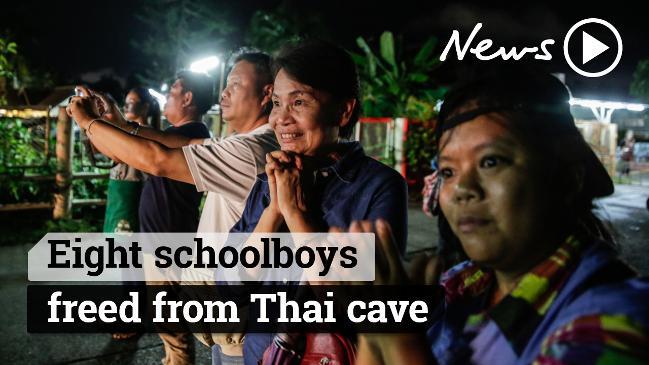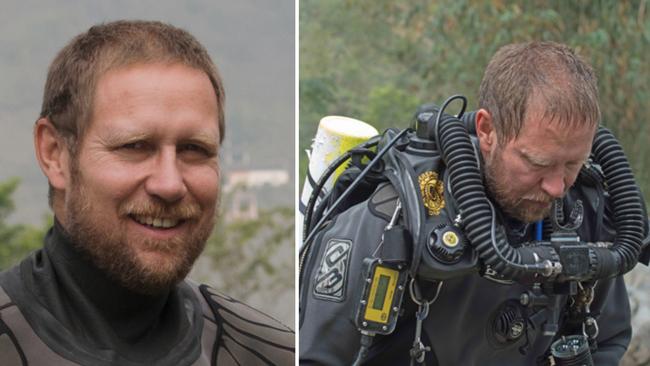The Australians behind the Thai cave rescue
LED by an Australian doctor and diving expert who chose which boys to save first, the Aussies are playing a key role in the Thai cave rescue.

THE Australian doctor and cave diving expert who’s playing a critical role in the mission to save a young Thai soccer team from their cave prison is a meticulous man, according to colleagues.
Adelaide anaesthetist and underwater cave explorer Richard “Harry” Harris risked his own life on Saturday to make the treacherous journey to the chamber where the boys have been trapped underground for 15 days.
It was on his advice the first four boys were cleared to make the incredibly dangerous journey out of the flooded cave complex, emerging alive on Sunday. Dr Harris, who has led record-breaking cave explorations, continues to play a key role in the international effort to rescue the remaining eight boys and their coach.
One former colleague says there are very good reasons why British caving experts working with Thai authorities at the site asked for his help. Bill Griggs used to be Dr Harris boss at South Australia’s emergency medical retrieval service, MedSTAR, where the anaesthetist still works. “To do cave-diving, you have to be all about attention to detail and you have to be meticulous,” Dr Griggs has told ABC radio.
“The combination of his medical knowledge and his cave diving skills was clearly (why) the British guys requested that he come as well.” Dr Harris, who has 30 years of diving experience, is well known in the cave diving community, including as the leader of record-breaking missions to explore a dark and dangerous underwater cave system on New Zealand’s South Island. In 2011 and 2012, he led a team of Aussie divers to record depths of 194 and 221 metres in what’s believed to be one of the world’s deepest cold water caves, searching for the source of the Pearse River.
He filmed the dangerous and complex mission for National Geographic. It required the team to set up a series of survival pods at intervals to allow divers to decompress, rest and eat in the near-freezing waters along the length of an underwater river — an experience that could prove invaluable in the current rescue mission.

Dr Harris’s dive team also had to contend with fast flowing water, as is the case in parts of the Thai cave complex, in water that was near freezing point. The rescue divers and boys in Thailand must dive, swim and climb their way to safety along a pitch-black tunnel that at points is barely big enough to allow an adult human body to wriggle through.
David Strike has known Dr Harris for more than 10 years and says his unique skill set gives the boys every chance of making it out.
“It’s an overused term, but all of those involved are true heroes,” he told Fairfax media.
In 2011, Dr Harris the difficult task of recovering the body of his friend, cave diver Agnes Milowka, after she ran out of air in Tank Cave at Millicent, near Mount Gambier in South Australia.
AUSTRALIANS INTEGRAL IN RESCUE
Australian Foreign Minister Julie Bishop said the Australian contingent had been integral in the first stage of the rescue mission, with the eight remaining boys and their soccer coach still in the cave waiting to be extracted.
“It’s highly dangerous, it’s very precarious and our thoughts are not only with the boys but also with the diving and rescue teams that are assisting,” Ms Bishop told the Nine Network on Monday.
The mission’s initial success has raised hopes for those still trapped, but officials say it could take four days to complete the entire rescue. Ms Bishop said lessons from the initial effort would be applied as two more groups of four are brought out of the cave.
“It’s wonderful news and we are very relieved that the four boys have been evacuated,” Ms Bishop said.
“But the fact that it took so many hours underscores how precarious this whole mission is.” Australian Federal Police and Defence Force divers, along with Adelaide cave diver and anaesthetist Richard Harris are part of the team working on the rescue.
Ms Bishop said Dr Harris was involved in the medical assessment which determined the first four boys were fit enough to swim to freedom.
“His qualifications and experience were certainly in demand,” she said.

THAILAND CAVE RESCUE TEAM: THE AUSTRALIANS
* The number of Australians helping with the dangerous Thai cave rescue operation varies depending on rotations, but up to 19 are involved.
* The group includes six Australian Federal Police divers supporting the Thai Navy, together with a liaison officer and interpreter.
* The divers formed part of the ‘daisy chain’ of rescuers who led four of the 12 boys out the cave system to the surface on Sunday.
* Richard Harris, a South Australian anaesthetist and diver was part of the medical team that determined the boys’ fitness to undertake the arduous four kilometre journey.
* Dr Harris and his diving support partner were deployed on July 6.
* An AFP Commander and a specialist response group supervisor arrived on July 6 to support the dive team in a co-ordination role.
* The AFP have also deployed a liaison officer, media co-ordinator, psychologist and chaplain.
* Two Australian Defence Force specialists have been deployed to assist rescue operation planning and recovery.
* ADF personnel based at the Australian Embassy in Bangkok have also been supporting co-ordination in Chiang Rai.
* Two Department of Foreign Affairs and Trade crisis response team officers have been deployed to assist the Australians with co-ordination.



